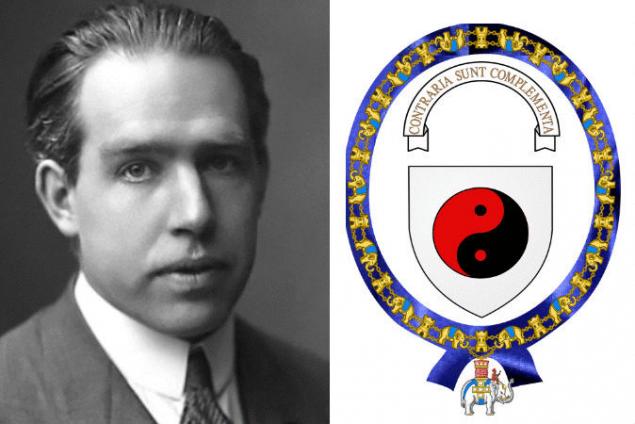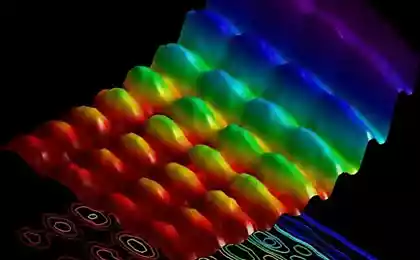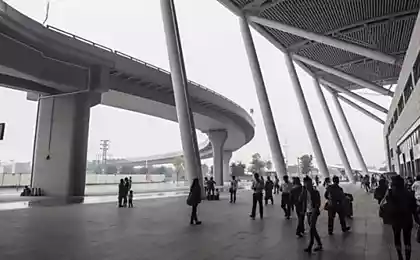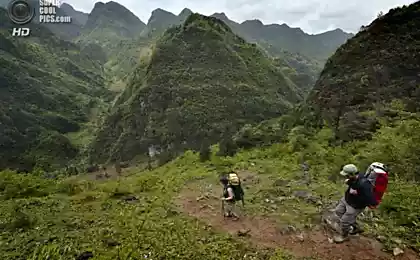468
The ancient Chinese concept, confirmed by modern physics
Niels Bohr, a pioneer of quantum mechanics, used the Taiji symbol of Yin and Yang in its arms. From his point of view, polarized particles complement each other like two opposing forces of Yin and Yang create balance in the Universe, in the Taoist sense. Bohr spoke of the unity of opposites in nature.

Many of the concepts in ancient Chinese science correspond to theories in physics, which was formed only in the last century. Here is a brief overview of several such ideas.
1. The eight trigrams and the location chastitsami trigrams described in the classic Chinese treatise "I Ching" ("Book of changes") is one of the most important and fundamental in Chinese history. These trigrams represent the basic principles of reality, they have an octagonal shape, reflecting their interaction with each other.
In his book "Tao of physics" (1975) physicist Fridtjof Capra wrote that this octagonal structure is in some sense similar to meson, "in which particles and antiparticles occupy opposite positions".
"Both modern physics and ancient Chinese thought consider change and transformation a key aspect of nature, and examines the structures and symmetries generated by the changes as secondary," he wrote.
2. "Book of changes" and the universal torecovery physics is based on two doctrines: the General theory of relativity and quantum mechanics. The problem is that they contradict each other.
In 1999, Brian Greene wrote in his nominated for a Pulitzer prize book "the Elegant universe": "the General theory of relativity and quantum mechanics in their current formulations cannot both be true simultaneously. The two theories underlying the tremendous progress in physics in the last hundred years, are mutually incompatible."
The theory of relativity successfully explains the structure of the Universe on a large scale, for example, the scale of stars and galaxies. Quantum mechanics studies the Universe on a microscopic scale at the level of atoms and subatomic particles. Scientists are still looking for the so-called universal theory, which would be able to cover everything.
String theory makes attempts in this direction. In a simplified interpretation of this theory considers the Universe in the form of strings and not single points. For example, the electron is perceived not as a point but as a string. If the string oscillates one way, it looks like an electron, if the second, we get a photon or a quark. These hypothetical strings originate in another dimension, where there is no gravity.
In the 70-ies of the last century became popular, although it was not universally accepted, theory of the scatterplot matrix, which was preceded by string theory.
At the time, Capra wrote: "the I Ching, probably the closest analogy to the theory of SPM in Eastern thought. In both systems the emphasis is on process, not objects. In theory the matrix of scattering these processes is the reaction of the particles, which give rise to all phenomena in the world of hadrons [type of subatomic particle].
In the "Book of changes" the basic processes are called change, and they are key for understanding all natural phenomena.
3. Lao-Tzu and subatomic, testiculo Tzu, founder of Taoism, in the sixth century wrote: "the Tao gave birth to one, one gave birth to two, two gave birth to three, three gave birth to miriada things. The myriad things carry Yin on their back and hold Yang in their arms."

Some believe that it is a philosophical statement similar to the description of different levels of particles: molecules, atoms, electrons, etc.
Electrons ― subatomic particles with a negative electric charge. Protons ― subatomic particle with a positive electric charge. These charges can be related to the polar forces of Yin and Yang in Taoism.
The ancient Greeks also had theories about atoms. Modern science has only discovered the electron in 1897, and other subatomic particles were discovered later.
Various prioritatile ancient Chinese science differ from goals of modern physics. Ancient Chinese scholars focused on the spiritual, they are recognized as tangible things and the intangible.
Some of the outstanding physicists of our time drew inspiration from the ancient Chinese science.
Quantum physics has proven that the observer can change the result of the experiment, just observing. "The mystics also say that the observer and the observed are United, they cease to be separate objects," says Capra in one of his interviews. It is even possible that the intention of the researcher can affect the outcome of the experiment. Some studies have shown that human thought can affect physical reality, even though it is not recognized by generally accepted science. Dean Radin from the Institute of noetic Sciences and William A. tiller of Stanford University are among the scientists studying this topic.
The starting point of the ancient science based on spirituality, and materialistic approach of modern science lead to different results.
"Western science since the seventeenth century was obsessed with the idea of control, of man dominating over nature... This obsession has led to disaster," said Capra.
Source: paranormal-news.ru/news/drevnekitajskie_koncepcii_podtverzhdjonnye_sovremennoj_fizikoj/2014-06-16-9217

Many of the concepts in ancient Chinese science correspond to theories in physics, which was formed only in the last century. Here is a brief overview of several such ideas.
1. The eight trigrams and the location chastitsami trigrams described in the classic Chinese treatise "I Ching" ("Book of changes") is one of the most important and fundamental in Chinese history. These trigrams represent the basic principles of reality, they have an octagonal shape, reflecting their interaction with each other.
In his book "Tao of physics" (1975) physicist Fridtjof Capra wrote that this octagonal structure is in some sense similar to meson, "in which particles and antiparticles occupy opposite positions".
"Both modern physics and ancient Chinese thought consider change and transformation a key aspect of nature, and examines the structures and symmetries generated by the changes as secondary," he wrote.
2. "Book of changes" and the universal torecovery physics is based on two doctrines: the General theory of relativity and quantum mechanics. The problem is that they contradict each other.
In 1999, Brian Greene wrote in his nominated for a Pulitzer prize book "the Elegant universe": "the General theory of relativity and quantum mechanics in their current formulations cannot both be true simultaneously. The two theories underlying the tremendous progress in physics in the last hundred years, are mutually incompatible."
The theory of relativity successfully explains the structure of the Universe on a large scale, for example, the scale of stars and galaxies. Quantum mechanics studies the Universe on a microscopic scale at the level of atoms and subatomic particles. Scientists are still looking for the so-called universal theory, which would be able to cover everything.
String theory makes attempts in this direction. In a simplified interpretation of this theory considers the Universe in the form of strings and not single points. For example, the electron is perceived not as a point but as a string. If the string oscillates one way, it looks like an electron, if the second, we get a photon or a quark. These hypothetical strings originate in another dimension, where there is no gravity.
In the 70-ies of the last century became popular, although it was not universally accepted, theory of the scatterplot matrix, which was preceded by string theory.
At the time, Capra wrote: "the I Ching, probably the closest analogy to the theory of SPM in Eastern thought. In both systems the emphasis is on process, not objects. In theory the matrix of scattering these processes is the reaction of the particles, which give rise to all phenomena in the world of hadrons [type of subatomic particle].
In the "Book of changes" the basic processes are called change, and they are key for understanding all natural phenomena.
3. Lao-Tzu and subatomic, testiculo Tzu, founder of Taoism, in the sixth century wrote: "the Tao gave birth to one, one gave birth to two, two gave birth to three, three gave birth to miriada things. The myriad things carry Yin on their back and hold Yang in their arms."

Some believe that it is a philosophical statement similar to the description of different levels of particles: molecules, atoms, electrons, etc.
Electrons ― subatomic particles with a negative electric charge. Protons ― subatomic particle with a positive electric charge. These charges can be related to the polar forces of Yin and Yang in Taoism.
The ancient Greeks also had theories about atoms. Modern science has only discovered the electron in 1897, and other subatomic particles were discovered later.
Various prioritatile ancient Chinese science differ from goals of modern physics. Ancient Chinese scholars focused on the spiritual, they are recognized as tangible things and the intangible.
Some of the outstanding physicists of our time drew inspiration from the ancient Chinese science.
Quantum physics has proven that the observer can change the result of the experiment, just observing. "The mystics also say that the observer and the observed are United, they cease to be separate objects," says Capra in one of his interviews. It is even possible that the intention of the researcher can affect the outcome of the experiment. Some studies have shown that human thought can affect physical reality, even though it is not recognized by generally accepted science. Dean Radin from the Institute of noetic Sciences and William A. tiller of Stanford University are among the scientists studying this topic.
The starting point of the ancient science based on spirituality, and materialistic approach of modern science lead to different results.
"Western science since the seventeenth century was obsessed with the idea of control, of man dominating over nature... This obsession has led to disaster," said Capra.
Source: paranormal-news.ru/news/drevnekitajskie_koncepcii_podtverzhdjonnye_sovremennoj_fizikoj/2014-06-16-9217























